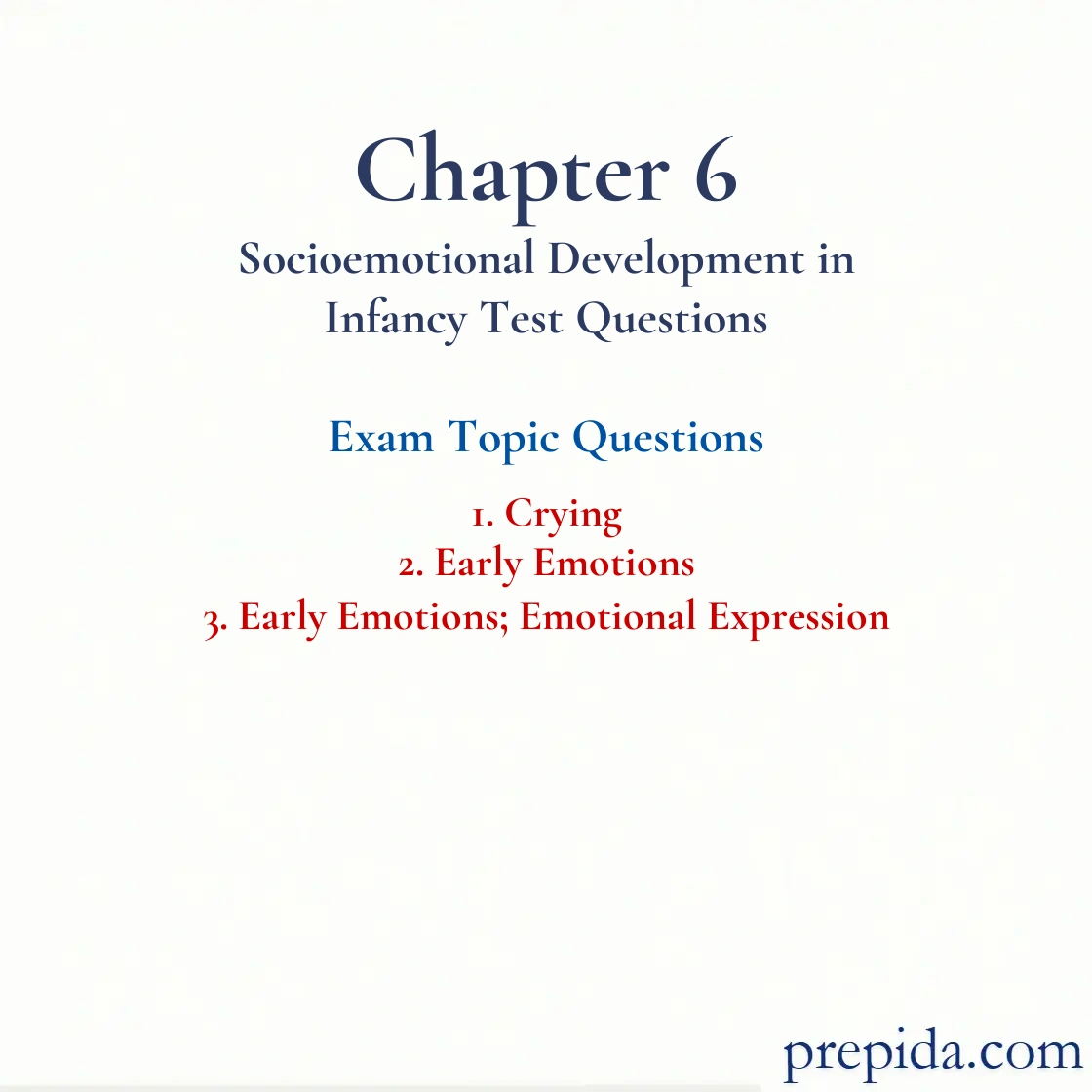
Which of the following statements is true of crying?
- Newborns seldom use crying as a means of communication.
- The first cry verifies that the infant's lungs are filled with fluids.
- Cries provide information about the health of the newborn's central nervous system.
- Excessive infant crying in 3-month-olds triples the risk of behavioral, hyperactive, and mood problems at 5 to 6 years of age.
Anger Cry: A variation of the basic cry, with more excess air forced through the vocal cords.
Two-month-old Trey is crying loudly. It is a sudden long, initial loud cry followed by breath holding. This type of cry indicates that Trey is
- experiencing pain.
- experiencing embarrassment.
- very angry.
- very hungry.
Pain Cry: A sudden appearance of a long, initial loud cry without preliminary moaning, followed by breath holding.
Mario brings his mother his favorite teddy bear to comfort her when she has had a bad day at work. This demonstrates a(n) ________ emotion.
- primary
- self-conscious
- negative
- unconscious
Self-Conscious Emotions: Emotions that require self-awareness, especially consciousness and a sense of “me”; examples include jealousy, empathy, and embarrassment.
Most ________ emotions occur for the first time at some point in the second half of the first year through the second year.
- unconscious
- primary
- negative
- self-conscious
Self-Conscious Emotions: Emotions that require self-awareness, especially consciousness and a sense of “me”; examples include jealousy, empathy, and embarrassment.
What is the opinion of experts on infant socioemotional development, such as Jerome Kagan, on an infant's capacity to display emotions like guilt, pride, despair, shame, empathy, and jealousy in the first year?
- The structural immaturity of the infant brain makes it unlikely that such emotions can be experienced in the first year.
- Infants characterized by negative affectivity are more prone to experience such emotions in the first year.
- The excitability of the amygdala plays an important role in the development of such emotions.
- Cultural differences in temperament prevent Asian infants from experiencing such emotions in the first year.
Emotion: Feeling, or affect, that occurs when a person is in a state or interaction that is important to him or her. Emotion is characterized by behavior that reflects (expresses) the pleasantness or unpleasantness of the state a person is in or the transactions being experienced.
Experts on infant socioemotional development, such as Jerome Kagan, conclude that ________ makes it unlikely that emotions which require thought can be experienced in the first year.
- the lack of innate emotions in the infant brain
- the structural immaturity of the infant brain
- incomplete myelination in the first two months
- the lack of reciprocity of emotional expressions
Emotion: Feeling, or affect, that occurs when a person is in a state or interaction that is important to him or her. Emotion is characterized by behavior that reflects (expresses) the pleasantness or unpleasantness of the state a person is in or the transactions being experienced.
Which of the following statements about self-conscious emotions is true?
- They are emotions that are present in humans and other animals.
- These emotions appear in the first six months of the infant's development.
- They include emotions like surprise, interest, joy, anger, sadness, fear, and disgust.
- They involve the emotional reactions of others when they are generated.
Self-Conscious Emotions: Emotions that require self-awareness, especially consciousness and a sense of “me”; examples include jealousy, empathy, and embarrassment.
Molly is an 18-month-old child who shows an "other-conscious" emotion when her caregiver praises her for doing a certain task in the presence of other children her age. Identify the emotion being described in this scenario.
- interest
- pride
- disgust
- fear
Emotion: Feeling, or affect, that occurs when a person is in a state or interaction that is important to him or her. Emotion is characterized by behavior that reflects (expresses) the pleasantness or unpleasantness of the state a person is in or the transactions being experienced.
Which of the following is a primary emotion?
- shame
- anger
- jealousy
- pride
Anger: Kübler-Ross’ second stage of dying, in which the dying person’s denial gives way to anger, resentment, rage, and envy.
Mark is a 4-month-old toddler. Which of the following emotions would he show at this age?
- primary
- tertiary
- other-conscious
- self-conscious
Emotions that are present in humans and animals and that appear in the first 6 months of the human infant's development are known as
- primitive emotions.
- innate emotions.
- primary emotions.
- evolved emotions.
Primary Emotions: Emotions that are present in humans and other animals and emerge early in life; examples are joy, anger, sadness, fear, and disgust.
Especially in infancy, emotions play important roles in ________.
- independence
- reciprocal socialization
- sensation
- behavioral organization
Organization: Piaget’s concept of grouping isolated behaviors and thoughts into a higher-order, more smoothly functioning cognitive system.
Which of the following is an important role played by emotions during infancy?
- cognition
- communication
- sensation
- suckling
Accommodation: Piagetian concept of adjusting schemes to fit new information and experiences.
Which of the following statements is true about emotions?
- Emotions are generally classified as positive or negative.
- Emotions are seldom influenced by biological foundations and experiences.
- The ability to regulate emotions is present at birth.
- Self-conscious emotions are the first to develop in an infant.
Five-month-old Caitlyn demonstrates surprise when an unexpected event occurs. This is a demonstration of a(n) ________ emotion.
- negative
- self-conscious
- other-conscious
- primary
Feelings or affects that occur when a person is in a state or an interaction that is important to him or her, especially to his or her well-being, are known as ________.
- temperament
- emotions
- personality trait
- feeling states
Which of the following terms is used to describe the mutually regulated interactions between parents and infants?
- other-conscious
- innate
- regulated
- synchronous